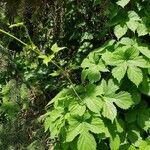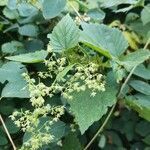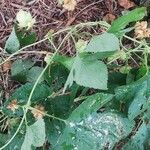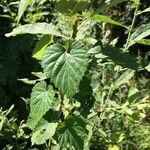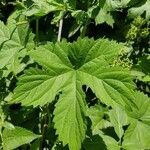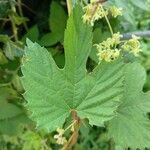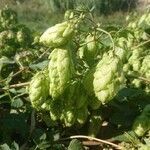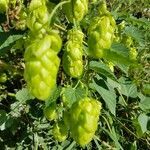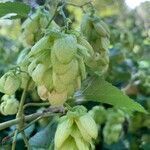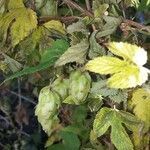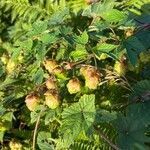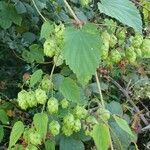Herbs , perennial, rhizomatous, 1-6(-7) m. Stems branched. Leaves: petioles usually shorter than blades. Leaf blade ± cordate, palmately 3-7-lobed, sometimes unlobed, 3-15 cm, margins dentate-serrate; surfaces abaxially with veins glabrous or with soft pubescence, without straight, erect hairs, glands yellow, adaxially margins of younger leaf blades with few or no cystolithic hairs. Inflorescences: staminate with flowers whitish to yellowish, anthers glandular; pistillate usually racemes, 10-20 mm, pedunculate; bracteole margins not ciliate-hairy. Infructescences pendulous, pale yellow, conelike, ovoid to oblong, (1-)2-3(-6) cm; bracteoles with yellow glands. Achenes yellowish, ovoid, compressed, glandular. 2 n = 20, including 2 or more sex-determining chromosomes.
Dioecious or monoecious climber, with extensive roots. Stems striate, up to 10 m long and clothed in rough deflexed hairs. Lvs broadly ovate, not lobed or deeply 3-5-lobed; lobes acute to acuminate, serrate, ± glabrous to sparsely hairy above, ± glabrous to moderately hairy with yellow glandular hairs below. Petiole usually ± = lf blade. Stipules 2 per node and 2-fid or 4 per node and entire. Bracts of ♀ fls triangular, hairy, green, elongating and becoming yellowish at fruiting to form a cylindric-ovoid infructescence (the hop) with yellow glandular hairs especially at base of bracts. Calyx of ♂ fls ovate-triangular, green, hairy. Achene ovate-ellipsoid, covered by glandular calyx.
Plants perennial. Petiole usually shorter than leaf blade; leaf blade 3-5(-7)-lobed, sometimes simple, 4-11 × 4-8 cm, abaxially glabrous or with scattered soft pubescence but without rigid spinulose hairs on veins, adaxially with few or no cystolith hairs marginally when young, base cordate, margin coarsely serrate, apex acute. Female flowers 2 per bract at least in middle of inflorescence; bracts imbricated into a globose spike. Infructescences globose, 3-4 cm in diam.; bracts ovoid, 1.5-2 cm, dry, membranous, apex acute. Achenes flat, included in bracts. Fl. autumn.
Rhizomatous perennial vine to 10 m; principal lvs as broad as long, cordate at base, 3-lobed to below the middle, the upper lvs often broadly ovate and lobeless; petiole shorter than the blade; staminate infls 5–15 cm; pistillate spikes 1 cm, becoming 3–6 cm, the persistent, accrescent bracts entire and mostly blunt, stramineous, very glandular at base; 2n=20. Moist soil; N.S. to Man., Mont., and Calif., s. to N.C., Ark., and Ariz., and widely distributed in the Old World. July, Aug. 5 geographically significant vars., 3 in our range.
A climbing twiner which keeps growing from year to year. It can be 4.5-7.5 m long. The stems are rough. The leaves are deeply lobed and light green. They are 10-15 cm long. There are teeth around the edge. The stems are square, thin and bristly. The flowers are green and cone-like. There are several named varieties.
